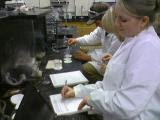
One of the curious things about curiosity is its ineffability. What causes one to be curious? From where does curiosity come? How does it work? There are no set guidelines for curiosity, no rules to follow. You can be curious about anything anywhere. Curiosity is not confined to any science or art, nor to any other discipline. It is not limited to a classroom setting.

Curiosity often begins in the classroom.

Through exposure to a variety of ideas and disciplines in the classroom, students become hungry for more information, more understanding; they become more curious. That curiosity spreads outside of the classroom as students embark on the infamous and collegiate search for knowledge.
Curiosity leads to a continuous search for knowledge. The curiosity that drives one's search for knowledge only intensifies as more information and fresh findings create new questions... and new curiosities.
Numerous examples of curiosity and the search for knowledge outside of the classroom exist at Clemson University.

Study groups form all over the campus as friends and classmates seek the help of others in their search for knowledge.

Chemistry students conduct comprehensive and thorough research in Clemson's Hunter laboratories.
Plant Biology students actively and enthusiastically investigate the various structures and functions of bryophytes in the laboratories of Clemson's Jordan Hall.
Some students need only a quiet room and a comfortable futon, along with the Internet and Clemson's impressive online databases to conduct research of their own.
Clemson's amphitheater is always a great place to witness curiosity at work.


There, students can be found working in study groups, searching the Internet, or working on school assignments alone.


Often, students use the amphitheater as a relaxing place to work, read, and study.
The amphitheater is not the only popular reading and studying spot....


Many students take advantage of quiet benches around Clemson's beautiful campus on nice days to catch up on studying or some personal reading.
Clemson's Celebration of Curiosity - "The Friday Flyers"

Artist John Acorn's "Friday Flyers," the six aluminum paper airplane sculptures located sporadically around Clemson's campus, are shining examples of Clemson University's commitment to inspire curiosity within students.
Each “airplane is an icon for the potential of what can be explored if curiosity and enthusiasm are maintained…. The release of [each] plane and its subsequent course parallels academia in the function of sending out the seeds of an idea for others to discover and explore. Both actions require embracing curiosity, imagination, and courage. Both journeys [are] influenced by variables such as knowledge, history, and environment. The [planes] communicate a powerful connection between the simplicity of childhood curiosity and higher education in the pursuit of knowledge. [Most of all,] Friday Flyers encourage viewers to remember [their] original inquisitive nature [and their] desire to realize dreams.”
(http://www.clemson.edu/caah/leegallery/art_partnership/existing_projects/acorn.php).
Clemson University inspires curiosity both in and out of the classroom, and one can find evidence of students' enthusiastic search for knowledge all over Clemson's beautiful campus.







1 comment:
I thought that your topic was very interesting.I never thought about how ones curiosity leads them in certain directions. and all over campus at that. i thought it was an interesting point of view to portray about how learning spreads all over campus in so many different directions. I really like the part about the planes, i wasnt sure of what they stood for, but i have seen them around and was curious about what they meant. and now i know.
Post a Comment